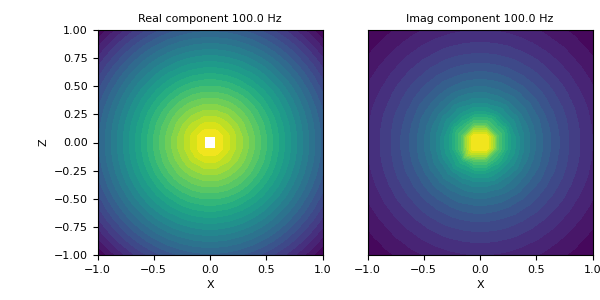geoana.em.fdem.MagneticDipoleWholeSpace.vector_potential#
- MagneticDipoleWholeSpace.vector_potential(xyz)#
Vector potential for the harmonic magnetic dipole at a set of gridded locations.
For a harmonic magnetic dipole oriented in the \(\hat{u}\) direction with moment amplitude \(m\), the electric vector potential at frequency \(f\) at vector distance \(\mathbf{r}\) from the dipole is given by:
\[\mathbf{F}(\mathbf{r}) = \frac{i \omega \mu m}{4 \pi r} e^{-ikr} \mathbf{\hat{u}}\]where
\[k = \sqrt{\omega^2 \mu \varepsilon - i \omega \mu \sigma}\]- Parameters:
- xyz(…, 3) numpy.ndarray
Gridded xyz locations
- Returns:
- (n_freq, …, 3) numpy.ndarray of complex
Magnetic vector potential at all frequencies for the gridded locations provided.
Examples
Here, we define an z-oriented magnetic dipole and plot the magnetic vector potential on the xy-plane that intercepts z=0.
>>> from geoana.em.fdem import MagneticDipoleWholeSpace >>> from geoana.utils import ndgrid >>> from geoana.plotting_utils import plot2Ddata >>> import numpy as np >>> import matplotlib.pyplot as plt
Let us begin by defining the electric current dipole.
>>> frequency = np.logspace(1, 3, 3) >>> location = np.r_[0., 0., 0.] >>> orientation = np.r_[0., 0., 1.] >>> moment = 1. >>> sigma = 1.0 >>> simulation = MagneticDipoleWholeSpace( >>> frequency, location=location, orientation=orientation, >>> moment=moment, sigma=sigma >>> )
Now we create a set of gridded locations and compute the vector potential.
>>> xyz = ndgrid(np.linspace(-1, 1, 20), np.linspace(-1, 1, 20), np.array([0])) >>> a = simulation.vector_potential(xyz)
Finally, we plot the real and imaginary components of the vector potential.
>>> f_ind = 1 >>> fig = plt.figure(figsize=(6, 3)) >>> ax1 = fig.add_axes([0.15, 0.15, 0.40, 0.75]) >>> plot2Ddata(xyz[:, 0:2], np.real(a[f_ind, :, 2]), ax=ax1, scale='log', ncontour=25) >>> ax1.set_xlabel('X') >>> ax1.set_ylabel('Z') >>> ax1.autoscale(tight=True) >>> ax1.set_title('Real component {} Hz'.format(frequency[f_ind])) >>> ax2 = fig.add_axes([0.6, 0.15, 0.40, 0.75]) >>> plot2Ddata(xyz[:, 0:2], np.imag(a[f_ind, :, 2]), ax=ax2, scale='log', ncontour=25) >>> ax2.set_xlabel('X') >>> ax2.set_yticks([]) >>> ax2.autoscale(tight=True) >>> ax2.set_title('Imag component {} Hz'.format(frequency[f_ind]))
(
Source code,png,pdf)